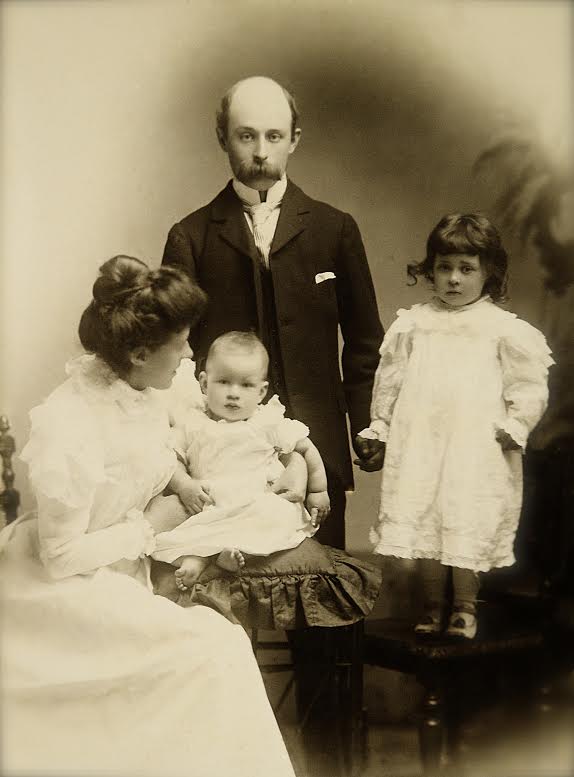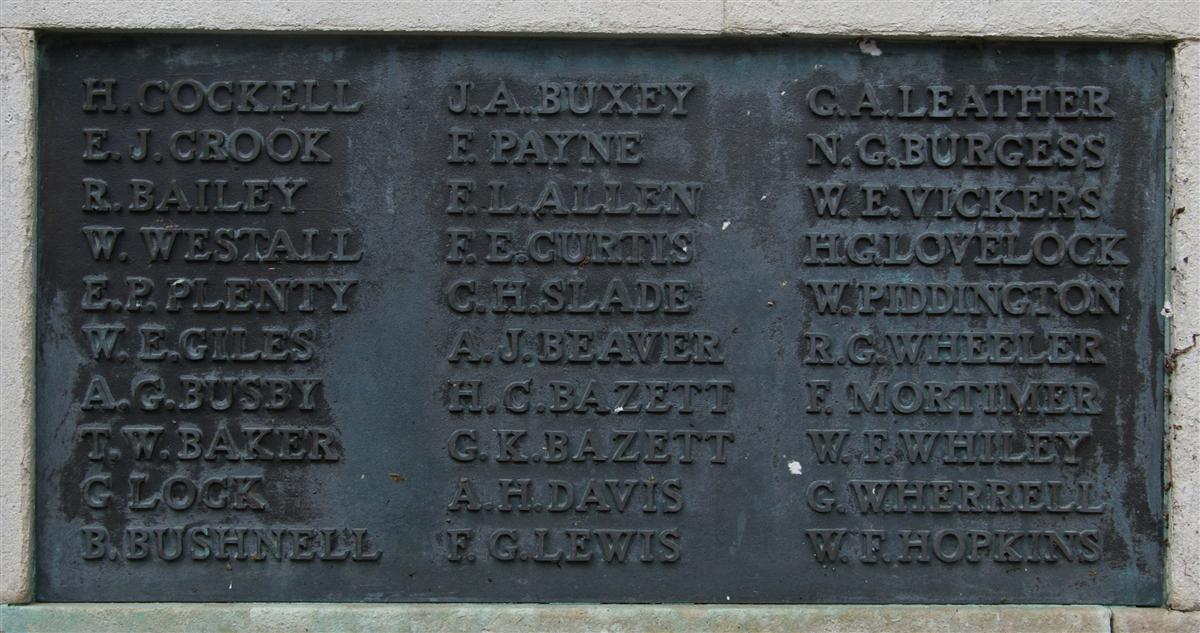Alan George Busby
Private Alan George Busby, 9th Battalion, Loyal North Lancashire Regiment
Alan was born in Appleton, near Abingdon, in 1886 the son of George Busby and his wife Sarah, née Burgess. Alan was the eldest son but far from the eldest child; he had four elder sisters: Louisa Jane (born 1878), Gertrude Anne (1879), Kathleen Palmer (1882), Mabel Grace (1884). More children followed Alan: twins Vera Margaret & Muriel Norah (1889), Grace Mabel (1893) and Harry James (1895). As was all too commonplace two of the children died young, Mabel in 1892, aged 8 and Kathleen in 1897, aged 15.
In 1891 George was a baker and grocer in Appleton, at the centre of village life, but it seems that the business was not successful as, by 1901, the family had moved in with Sarah’s mother, Louisa Hughes, in Boxford where George was working on a local estate. However, Alan was not with them, aged only 14 he was living in Woodlands St Mary with Henry Bew and his family. Henry was another grocer and baker and was employing young Alan in the bakery. Alan’s relationship with the Bew family appears to have grown to be more than that of an employee – to the extent that Henry’s son, Francis John Bew would be the man to whom Alan entrusted his estate as executor of his will.
Alan seems to have been a conscientious worker, and also an ambitious man. He left Henry Bew’s small business in Woodland St Mary to join/take over Henry Pavier’s carrier business transporting goods and people between Lambourn and Newbury. Every Tuesday, Thursday and Saturday morning he would take his cart from Lambourn to Newbury leaving for the return journey from the Queen’s Hotel in the Market Place at Newbury at 3.30pm. On Wednesdays he would make a similar round trip to Hungerford. In the 1911 census he was boarding with Henry Pavier and his wife in Newbury Street, Lambourn. This was far more lucrative than being employed as a baker, so much so that he was to leave a considerable sum when he died.

81 Russell Road - 1 Ena Terrace when Alan's parents moved there in 1907 |
When war was declared in August 1914 a great many young men responded to the call to arms and enlisted with the army or navy, but not Alan. Even if he was minded to do so his business could disappear if he was not around. However, in 1916 the Government introduced conscription and Alan had no choice in the matter; in June 1916 he donned the khaki uniform and began his training with a Cyclist battalion. When he was ready for the Front he was sent to an Infantry Base Depot (IBD) in France (probably in Etaples), whence he was posted to the 9th Battalion of the Loyal North Lancashire Regiment. This battalion received several drafts of men from the 25th IBD between 13 and 25 December 1916 in total adding 262 men to their strength. So it is very possible that Alan spent his last Christmas in Ploegsteert Wood – famously known to the British troops as Plug Street Wood.
The unit that he had joined was a part of the 74th Brigade, 25th Division in the British 2nd Army, commanded by General Sir Hubert Plumer. For some months Plumer had been planning an attack on the German positions along the Messines (Mesen) – Wytschaete ridge. This ridge ran from Pleogsteert in the south to Mt Sorrel in the north and was a real problem to the British. Germans on this high ground had a good view north over the Ypres Salient, making any Allied offensive in that area extremely vulnerable to German artillery. However, it was also vulnerable itself being a German held salient protruding into British held territory.
Plumer had long been pushing for an assault on the ridge, indeed it had originally been envisaged as a follow up to a successful assault along the Somme front in July 1916. However, the Somme offensive was not the instant success that was envisaged and the ongoing commitment on that front absorbed all resources for months – resulting in the abandonment of Plumer’s planned assault on the ridge.
Despite this setback Plumer did not give up on the idea, not least because extensive mining activities meant that huge quantities of explosive were already underground, waiting for the moment to remove several major German defensive strongpoints from the face of the earth. He was eventually given the go ahead to attack on 7 June 1917.
The attack began with the detonation of 19 huge mines – huge concrete blockhouses flew into the air coming down in bits. 18 huge craters were created, many of which can still be seen almost 100 years later. The 19th mine was under a strongpoint designated Ontario Farm where the mine resulted in the sandy ground rising into the air and falling back into the same place with no discernible crater but a muddy, steaming patch which bubbled gently for several days. Ontario Farm, its strongpoint and garrison had disappeared into the morass.1 The 25th Division attacked the section of the line between Ontario Farm and Kruistraat to the north. To their right was the New Zealand Division, to their left the 36th Division.
The offensive continued for a week and was a great strategic success, the Germans were evicted from their positions and the British could go ahead with their plans to attack out of the Ypres Salient, without worrying about German artillery spotters on the Messines-Wytschaete Ridge. The path was clear for the launch of the Third Battle of Ypres – better known as Passchendaele.
The 9th Battalion, Loyal North Lancashire took part on the opening day of the assault by the 25th Division, though their war diary gives little information on the day’s activities:
War Diary, 9th Battalion, Loyal North Lancashire Regiment - 7 June 1917
Battalion took part in attack on MESSINES-WYTCHAETE RIDGE.
Casualties in Officers:- Killed, Capt R D Robinson; Wounded, Capt F G Lawrie, Lieut G R Sharpe, Lieut H J Shipp, LieutL H Lanham, Lieut L W Nolan, 2nd Lieut S Sefton, 2nd Lieut T Pollett, Wnd Lt R Harp. 2nd Lt A Cross, 2nd Lt W A Dundas, 2nd Lt T H Elkington, 2nd Lt R L Brock
Battalion held OCTOBER & OCTOBER SUPPORT TRENCHES.
As can be seen there were numerous casualties among the officers, which, of course, were accompanied by equally heavy losses among the other ranks. Sadly Alan fell that day. A letter from the husband of a neighbour of the Busbys reported that he was killed by a bomb as they came out of the trenches for a short rest. This, as reported in the local paper, reads oddly – in WW1 terminology a bomb was a hand grenade, not the weapon likely to injure a man coming out of the trenches for a rest, unless he or one of his comrades let one off accidently. Of course it could be that the letter was misreported in the paper and that it was shellfire that killed him. In any case the letter is typical of letters from the front to bereaved relatives – their son/husband always died instantaneously or without pain.
A detailed report of Alan’s death appeared three weeks after his death:
Newbury Weekly News, 28 June 1917 – Local War Notes
The official news of the death of Pte Alan Busby, was received on Tuesday afternoon by the parents of deceased, who live at 1, Ena-terrace, Russell-road, Newbury. Incidentally they had heard some ten days previously from a neighbour, Mrs Purton, of Burton-terrace, a letter from her husband stating that Busby and another private had been struck by a bomb and killed instantaneously just as they had come out of the trenches for a short rest. Deceased prior to joining up last June, was a carrier between Lambourn and Newbury, previous to which he was in the employ of Mr Bew, baker, of Lambourn Woodlands, and from his obliging and straightforward conduct, deceased had made many friends throughout the district. Originally he was attached to a cyclist corps, and was in training at Chiseldon, going out to France just before last Christmas; he was transferred to the North Lancs. Letters and post-cards continued to reach his friends. The last was written from a four days rest en march, in what he described as being a beautiful stream, in which the men bathed three or four times a day. He begged his mother to send out no more parcels, whether from premonitory promptings, or from a feeling she should not stint herself by so doing, will, perhaps, never be known. The parents have one other son; he is at present in this country engaged in the air service.
Alan’s body had not been identified, a common fate of those killed by shellfire, so his name is remembered on the Menin Gate at Ieper, the iconic memorial to the missing from the Ypres Salient.

Walter's name on Newbury War Memorial (upper middle) |
Alan’s brother Harry also served his country, volunteering for the Royal Navy on 10 November 1914. However, he did not get to see the world, barely even seeing the sea! He started his Navy career as an air mechanic, but his pre-war occupation as a chauffeur meant that he was appointed as a driver on 5 November 1915. He spent the rest of his war as a member of a mobile Royal Navy Air Service anti-aircraft team, equipped with a quick-firing gun mounted on a lightly armoured car. Based at the London shore establishment, HMS President, he was a small part of London’s defensives against enemy Zeppelins and bombers.

Find a memorial :
| Died this day: | |
| 14 January 1944 | |
| R G Layley | |
| Newbury |

Like this site? Show your appreciation through a donation to a great charity.